2013 FORD SUPER DUTY ESP
[x] Cancel search: ESPPage 3 of 95

POWER STROKE DIESEL ENGINE
Note:Your vehicle’s powertrain control systems can detect and store
information about vehicle modifications that increase horsepower and
torque output such as whether or not performance-enhancing powertrain
components commonly referred to as “performance chips” have been
used. This information cannot be erased and will stay in the system’s
memory even if the modification is removed. The information can be
retrieved by Ford Motor Company, Ford of Canada, and service and
repair facilities when servicing your vehicle. This information may be
used to determine if repairs will be covered by warranty.
Note:Some aftermarket products may cause severe engine/transmission
and/or exhaust system damage; refer to your warranty information for
more information.
Your new diesel engine will feel, drive and function somewhat differently
than a gasoline engine. Therefore it is very important that you read and
thoroughly familiarize yourself and others operating the vehicle with this
guide. A special procedure for turning off the diesel engine is in the
Starting and Stopping the Enginechapter.It is important to read
and understand this material in order to maintain the best
service life for your engine.
This supplement will acquaint you with the Power Stroke diesel engine.
It provides recommendations on engine care and operating procedures.
For complete vehicle information, also refer to yourOwner’s Manual
included with the vehicle. It also describes equipment and gives
specifications for equipment that was in effect when this guide was
approved for printing, and should be considered a permanent part of the
vehicle.
Ford may discontinue models or change specifications without any notice
and without incurring obligations.
WARNINGS
Throughout this guide, you will find warnings identified by the warning
symbol. Warnings remind you to be especially careful to reduce the risk
of personal injury.
Introduction
2
2013 Diesel(67l)
Supplement, 1st Printing
USA(fus)
Page 6 of 95
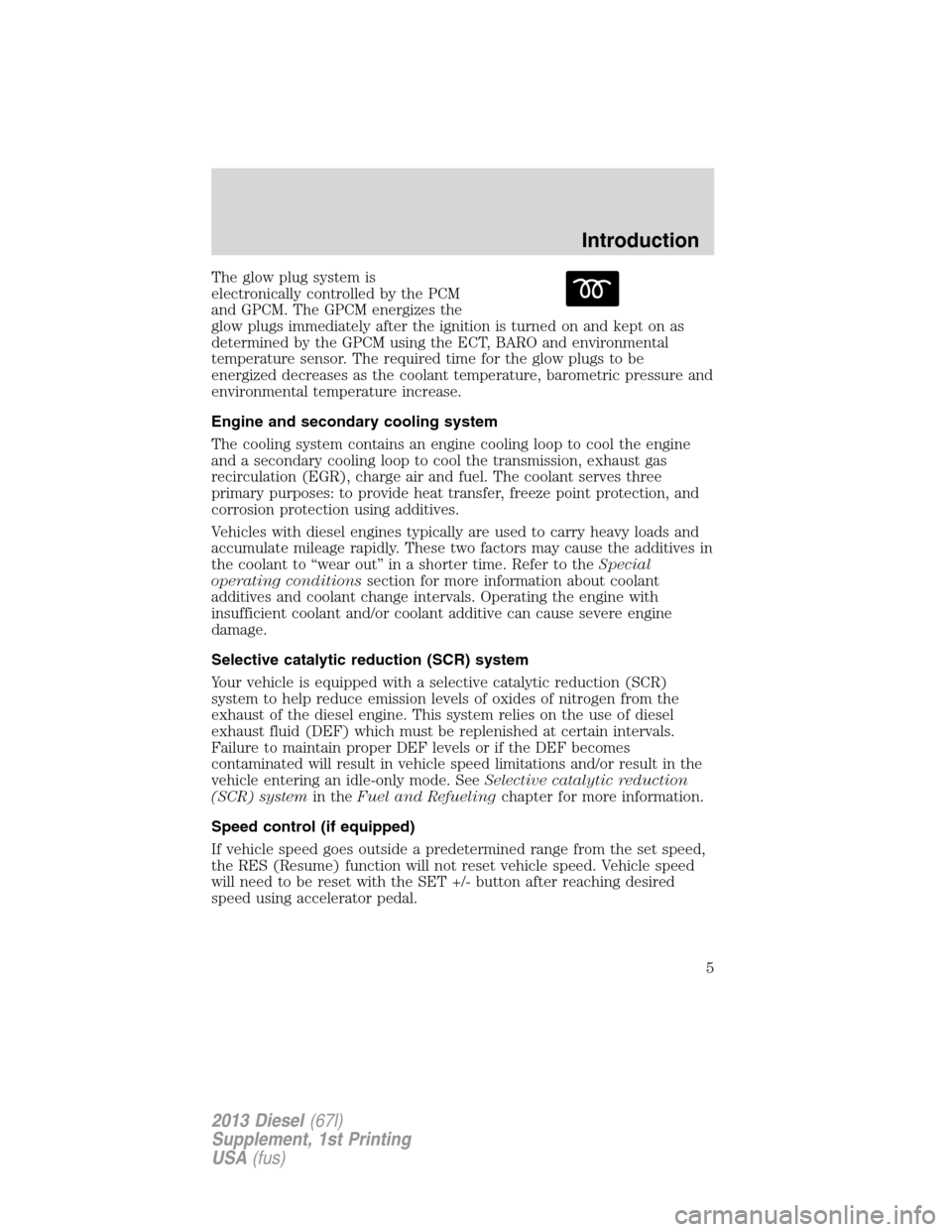
The glow plug system is
electronically controlled by the PCM
and GPCM. The GPCM energizes the
glow plugs immediately after the ignition is turned on and kept on as
determined by the GPCM using the ECT, BARO and environmental
temperature sensor. The required time for the glow plugs to be
energized decreases as the coolant temperature, barometric pressure and
environmental temperature increase.
Engine and secondary cooling system
The cooling system contains an engine cooling loop to cool the engine
and a secondary cooling loop to cool the transmission, exhaust gas
recirculation (EGR), charge air and fuel. The coolant serves three
primary purposes: to provide heat transfer, freeze point protection, and
corrosion protection using additives.
Vehicles with diesel engines typically are used to carry heavy loads and
accumulate mileage rapidly. These two factors may cause the additives in
the coolant to “wear out” in a shorter time. Refer to theSpecial
operating conditionssection for more information about coolant
additives and coolant change intervals. Operating the engine with
insufficient coolant and/or coolant additive can cause severe engine
damage.
Selective catalytic reduction (SCR) system
Your vehicle is equipped with a selective catalytic reduction (SCR)
system to help reduce emission levels of oxides of nitrogen from the
exhaust of the diesel engine. This system relies on the use of diesel
exhaust fluid (DEF) which must be replenished at certain intervals.
Failure to maintain proper DEF levels or if the DEF becomes
contaminated will result in vehicle speed limitations and/or result in the
vehicle entering an idle-only mode. SeeSelective catalytic reduction
(SCR) systemin theFuel and Refuelingchapter for more information.
Speed control (if equipped)
If vehicle speed goes outside a predetermined range from the set speed,
the RES (Resume) function will not reset vehicle speed. Vehicle speed
will need to be reset with the SET +/- button after reaching desired
speed using accelerator pedal.
Introduction
5
2013 Diesel(67l)
Supplement, 1st Printing
USA(fus)
Page 7 of 95
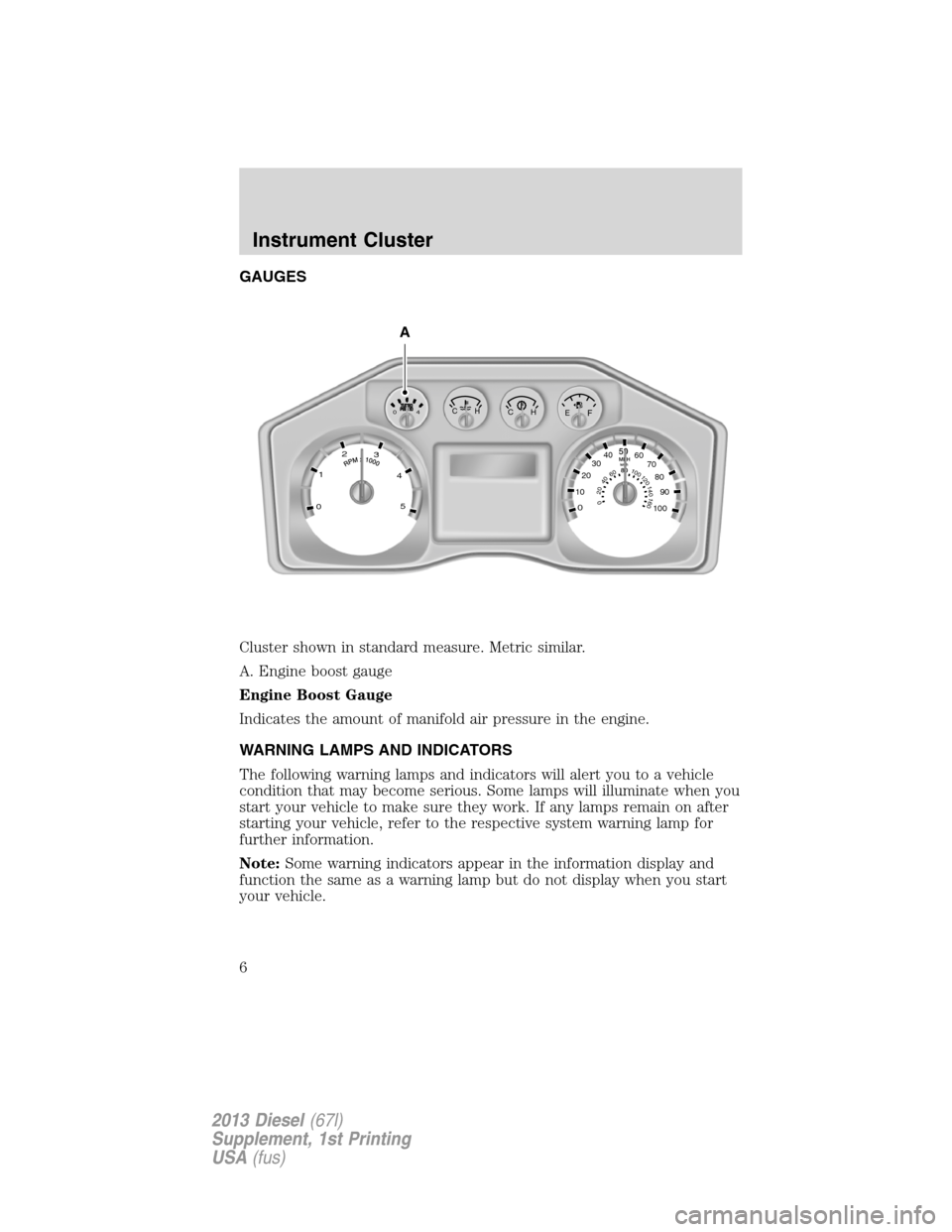
GAUGES
Cluster shown in standard measure. Metric similar.
A. Engine boost gauge
Engine Boost Gauge
Indicates the amount of manifold air pressure in the engine.
WARNING LAMPS AND INDICATORS
The following warning lamps and indicators will alert you to a vehicle
condition that may become serious. Some lamps will illuminate when you
start your vehicle to make sure they work. If any lamps remain on after
starting your vehicle, refer to the respective system warning lamp for
further information.
Note:Some warning indicators appear in the information display and
function the same as a warning lamp but do not display when you start
your vehicle.
A
60
70
80
90
100
02
0406
01001201401600
10203040012
3
4
5
CH04CHEF
Instrument Cluster
6
2013 Diesel(67l)
Supplement, 1st Printing
USA(fus)
Page 11 of 95
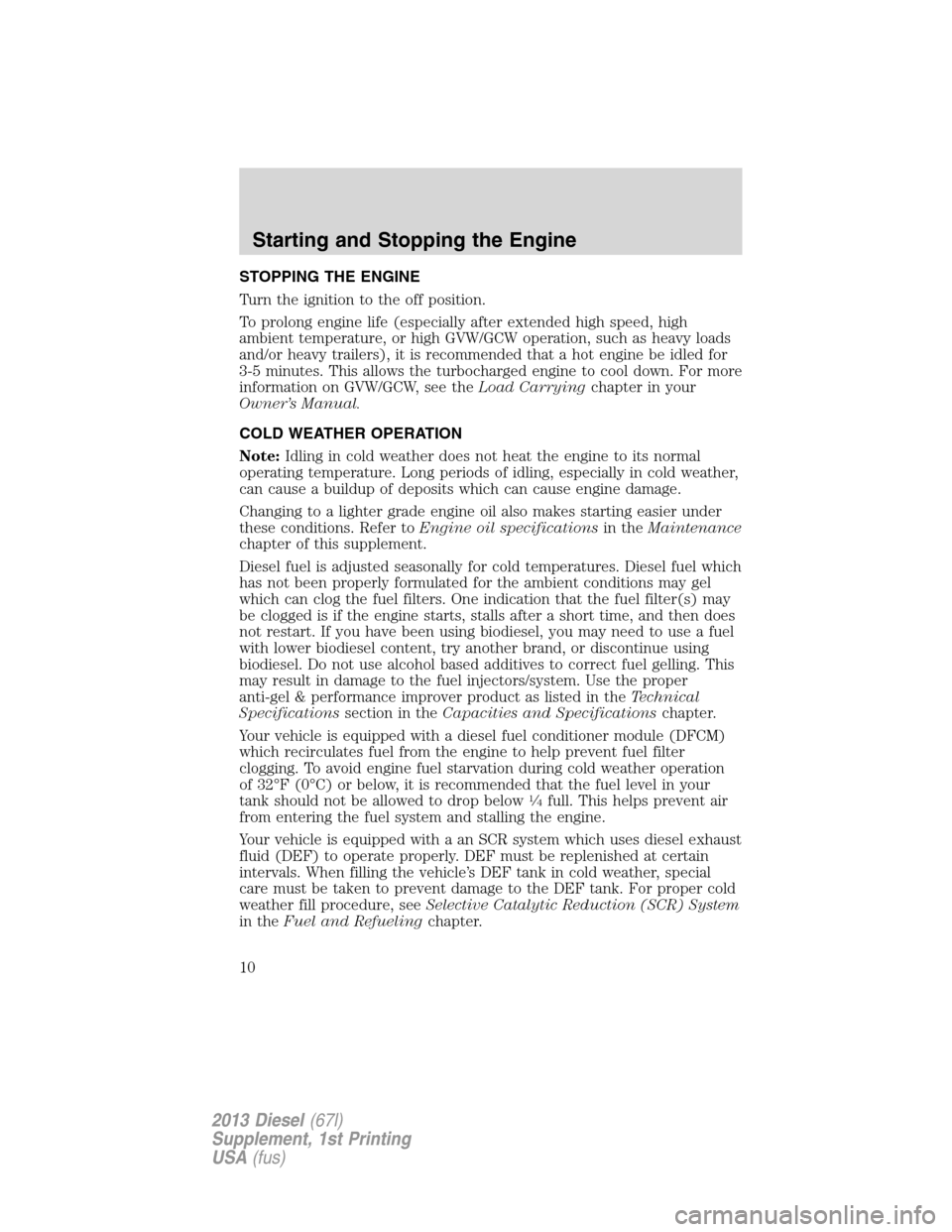
STOPPING THE ENGINE
Turn the ignition to the off position.
To prolong engine life (especially after extended high speed, high
ambient temperature, or high GVW/GCW operation, such as heavy loads
and/or heavy trailers), it is recommended that a hot engine be idled for
3-5 minutes. This allows the turbocharged engine to cool down. For more
information on GVW/GCW, see theLoad Carryingchapter in your
Owner’s Manual.
COLD WEATHER OPERATION
Note:Idling in cold weather does not heat the engine to its normal
operating temperature. Long periods of idling, especially in cold weather,
can cause a buildup of deposits which can cause engine damage.
Changing to a lighter grade engine oil also makes starting easier under
these conditions. Refer toEngine oil specificationsin theMaintenance
chapter of this supplement.
Diesel fuel is adjusted seasonally for cold temperatures. Diesel fuel which
has not been properly formulated for the ambient conditions may gel
which can clog the fuel filters. One indication that the fuel filter(s) may
be clogged is if the engine starts, stalls after a short time, and then does
not restart. If you have been using biodiesel, you may need to use a fuel
with lower biodiesel content, try another brand, or discontinue using
biodiesel. Do not use alcohol based additives to correct fuel gelling. This
may result in damage to the fuel injectors/system. Use the proper
anti-gel & performance improver product as listed in theTechnical
Specificationssection in theCapacities and Specificationschapter.
Your vehicle is equipped with a diesel fuel conditioner module (DFCM)
which recirculates fuel from the engine to help prevent fuel filter
clogging. To avoid engine fuel starvation during cold weather operation
of 32°F (0°C) or below, it is recommended that the fuel level in your
tank should not be allowed to drop below
1�4full. This helps prevent air
from entering the fuel system and stalling the engine.
Your vehicle is equipped with a an SCR system which uses diesel exhaust
fluid (DEF) to operate properly. DEF must be replenished at certain
intervals. When filling the vehicle’s DEF tank in cold weather, special
care must be taken to prevent damage to the DEF tank. For proper cold
weather fill procedure, seeSelective Catalytic Reduction (SCR) System
in theFuel and Refuelingchapter.
Starting and Stopping the Engine
10
2013 Diesel(67l)
Supplement, 1st Printing
USA(fus)
Page 12 of 95

In cold weather below 32°F (0°C), the engine may slowly increase to a
higher idle speed if left idling in P (Park). As the engine warms-up, the
engine sound level decreases due to the activation of PCM-controlled
sound reduction features.
If your vehicle is operated in a heavy snow storm or blowing snow
conditions, the engine air induction may become partially clogged with
snow and/or ice. If this occurs, the engine may experience a significant
reduction in power output. At the earliest opportunity, clear all the snow
and/or ice away from inside the air filter assembly. Remove the air
cleaner cover and the pleated paper filter, leaving the foam filter in and
remove any snow or ice. Make sure the foam filter is installed correctly
in place. Remove any debris, snow and/or ice on the foam filter by
brushing the surface with soft brush. Do not use water, solvents, or a
hard brush for cleaning the foam filter.
In order to operate the engine in temperatures of 32°F (0°C) or lower,
read the following instructions:
•Make sure that the batteries are of sufficient size and are fully
charged. Check other electrical components to make sure they are in
optimum condition.
•Use the proper coolant solution at the concentration recommended to
protect the engine against damage from freezing.
•Try to keep the fuel tank full as much as possible at the end of
operation to prevent condensation in the fuel system.
•Make sure you use proper cold weather engine oil and that it is at its
proper level. Also, if necessary, make sure to follow the engine oil and
filter change schedule found under theSpecial operating conditions
section listed in thescheduled maintenance information.
•At temperatures of -10°F (-23°C) or below, it is recommended that
you use an engine block heater to improve cold engine starting.
•If operating in arctic temperatures of -20°F (-29°C) or lower, consult
your truck dealer for information about special cold weather
equipment and precautions.
The following cold weather idling guidelines are recommended:
•Motorcraft® cetane improvers or non-alcohol-based cetane improvers
from a reputable manufacturer may be used as needed.
•Maintain the engine cooling system properly.
•Avoid shutting the engine down after an extensive idling period. Drive
the vehicle for several miles with the engine at normal operating
temperatures under a moderate load.
•Consider using an engine block heater.
•For extended idle times use an approved idle speed increase device.
Starting and Stopping the Engine
11
2013 Diesel(67l)
Supplement, 1st Printing
USA(fus)
Page 17 of 95
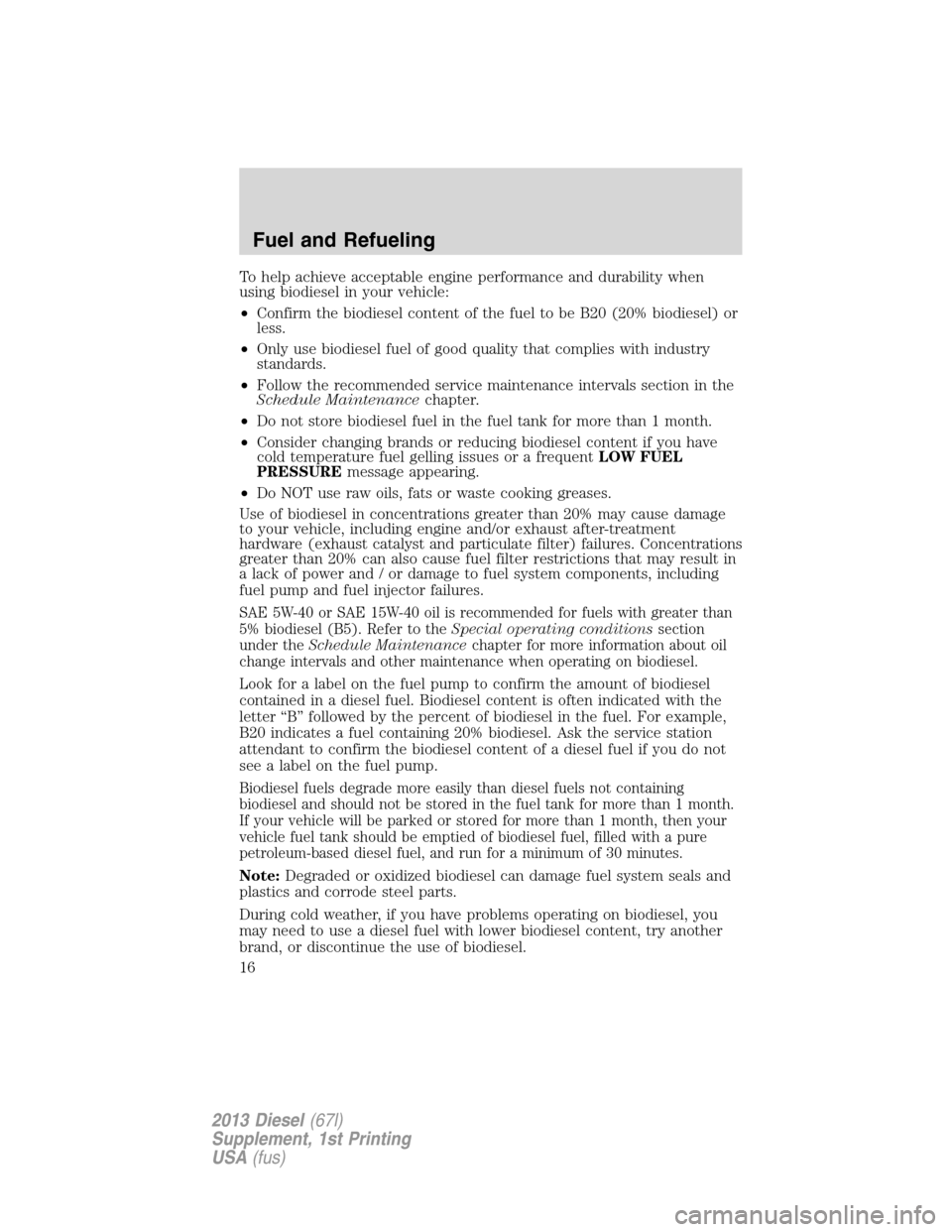
To help achieve acceptable engine performance and durability when
using biodiesel in your vehicle:
•Confirm the biodiesel content of the fuel to be B20 (20% biodiesel) or
less.
•Only use biodiesel fuel of good quality that complies with industry
standards.
•Follow the recommended service maintenance intervals section in the
Schedule Maintenancechapter.
•Do not store biodiesel fuel in the fuel tank for more than 1 month.
•Consider changing brands or reducing biodiesel content if you have
cold temperature fuel gelling issues or a frequentLOW FUEL
PRESSUREmessage appearing.
•Do NOT use raw oils, fats or waste cooking greases.
Use of biodiesel in concentrations greater than 20% may cause damage
to your vehicle, including engine and/or exhaust after-treatment
hardware (exhaust catalyst and particulate filter) failures. Concentrations
greater than 20% can also cause fuel filter restrictions that may result in
a lack of power and / or damage to fuel system components, including
fuel pump and fuel injector failures.
SAE 5W-40 or SAE 15W-40 oil is recommended for fuels with greater than
5% biodiesel (B5). Refer to theSpecial operating conditionssection
under theSchedule Maintenancechapter for more information about oil
change intervals and other maintenance when operating on biodiesel.
Look for a label on the fuel pump to confirm the amount of biodiesel
contained in a diesel fuel. Biodiesel content is often indicated with the
letter “B” followed by the percent of biodiesel in the fuel. For example,
B20 indicates a fuel containing 20% biodiesel. Ask the service station
attendant to confirm the biodiesel content of a diesel fuel if you do not
see a label on the fuel pump.
Biodiesel fuels degrade more easily than diesel fuels not containing
biodiesel and should not be stored in the fuel tank for more than 1 month.
If your vehicle will be parked or stored for more than 1 month, then your
vehicle fuel tank should be emptied of biodiesel fuel, filled with a pure
petroleum-based diesel fuel, and run for a minimum of 30 minutes.
Note:Degraded or oxidized biodiesel can damage fuel system seals and
plastics and corrode steel parts.
During cold weather, if you have problems operating on biodiesel, you
may need to use a diesel fuel with lower biodiesel content, try another
brand, or discontinue the use of biodiesel.
Fuel and Refueling
16
2013 Diesel(67l)
Supplement, 1st Printing
USA(fus)
Page 57 of 95

13. If necessary, add prediluted engine coolant to the coolant reservoir
until the coolant level is within the COLD FILL RANGE as listed on the
reservoir. After any coolant has been added, check the coolant
concentration. SeeEngine and secondary cooling system coolant
earlier in the chapter for more information.
Whenever coolant has been added, the coolant level in the reservoir
should be checked the next few times you drive the vehicle. If needed,
add prediluted engine coolant to bring the coolant to the proper level.
Recycled engine coolant
Ford Motor Company does not recommend the use of recycled engine
coolant since a Ford-approved recycling process is not yet available.
Always dispose of used automotive fluids in a responsible manner. Follow
your community’s regulations and standards for recycling and disposing
of automotive fluids.
Coolant refill capacity
To find out how much fluid your vehicle’s cooling system can hold, refer
to theCapacities and Specificationschapter.
Severe climates
If you drive in extremely cold climates:
•It may be necessary to have a Ford authorized dealer increase the
coolant concentration above 50%.
•A coolant concentration of 60% will provide improved freeze point
protection. Engine coolant concentrations above 60% will decrease the
overheat protection characteristics of the engine coolant and may
cause engine damage.
If you drive in extremely hot climates:
•It may be necessary to have a Ford authorized dealer decrease the
coolant concentration to 40%.
•A coolant concentration of 40% will provide improved overheat
protection. Engine coolant concentrations below 40% will decrease the
corrosion/freeze protection characteristics of the engine coolant and
may cause engine damage.
Vehicles driven year-round in non-extreme climates should use
prediluted engine coolant for optimum cooling system and engine
protection.
Maintenance
56
2013 Diesel(67l)
Supplement, 1st Printing
USA(fus)
Page 71 of 95
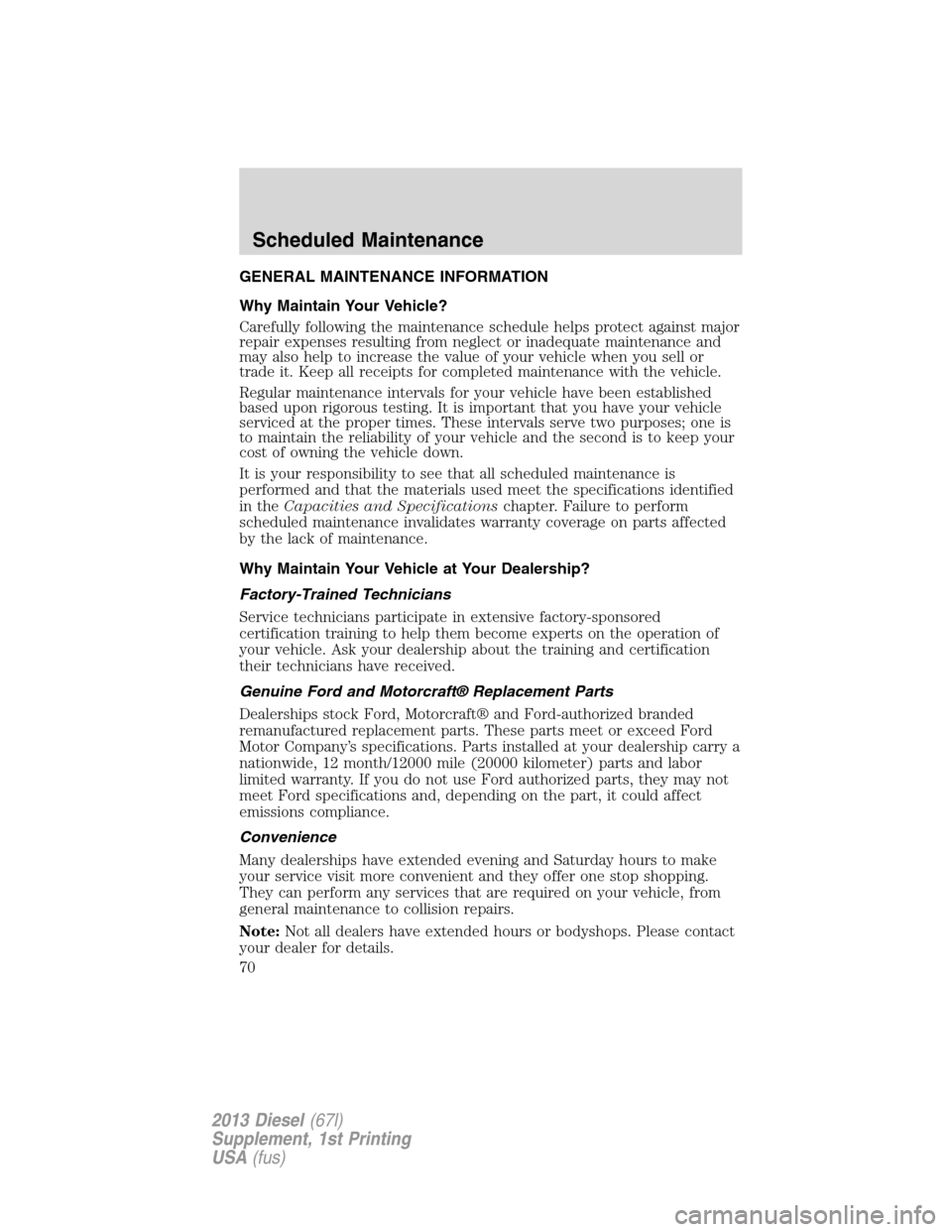
GENERAL MAINTENANCE INFORMATION
Why Maintain Your Vehicle?
Carefully following the maintenance schedule helps protect against major
repair expenses resulting from neglect or inadequate maintenance and
may also help to increase the value of your vehicle when you sell or
trade it. Keep all receipts for completed maintenance with the vehicle.
Regular maintenance intervals for your vehicle have been established
based upon rigorous testing. It is important that you have your vehicle
serviced at the proper times. These intervals serve two purposes; one is
to maintain the reliability of your vehicle and the second is to keep your
cost of owning the vehicle down.
It is your responsibility to see that all scheduled maintenance is
performed and that the materials used meet the specifications identified
in theCapacities and Specificationschapter. Failure to perform
scheduled maintenance invalidates warranty coverage on parts affected
by the lack of maintenance.
Why Maintain Your Vehicle at Your Dealership?
Factory-Trained Technicians
Service technicians participate in extensive factory-sponsored
certification training to help them become experts on the operation of
your vehicle. Ask your dealership about the training and certification
their technicians have received.
Genuine Ford and Motorcraft® Replacement Parts
Dealerships stock Ford, Motorcraft® and Ford-authorized branded
remanufactured replacement parts. These parts meet or exceed Ford
Motor Company’s specifications. Parts installed at your dealership carry a
nationwide, 12 month/12000 mile (20000 kilometer) parts and labor
limited warranty. If you do not use Ford authorized parts, they may not
meet Ford specifications and, depending on the part, it could affect
emissions compliance.
Convenience
Many dealerships have extended evening and Saturday hours to make
your service visit more convenient and they offer one stop shopping.
They can perform any services that are required on your vehicle, from
general maintenance to collision repairs.
Note:Not all dealers have extended hours or bodyshops. Please contact
your dealer for details.
Scheduled Maintenance
70
2013 Diesel(67l)
Supplement, 1st Printing
USA(fus)